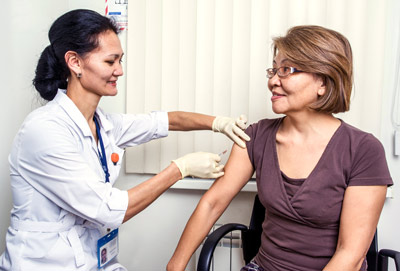Itʼs midnight and youʼre burning with fever. You power up your computer and visit one of the many Websites that feature online access to physicians 24/7. Within minutes, youʼre engaging in a video consultation with a board-certified physician who evaluates you, provides clinical instruction, and even prescribes medication in some cases. Soon afterwards, youʼre back in bed resting with a prescription waiting to be filled.
Welcome to the world of telehealth (also called telemedicine), where the use of electronic information and telecommunications technologies supports long-distance clinical care. It is a world in which access to healthcare is paramount and simple. Distance is no longer a barrier to services because technology is there to fill the gap.
Dr. Ryan Copeland, Regional Medical Director at International SOS, which provides remote medical assistance to millions of clients around the world, says ISO/TS 13131 guidelines for the delivery of telehealth services enable the company to ensure consistent, quality remote medical assistance while safeguarding a clientʼs private data. And the skyʼs the limit in this new medical niche.
Working in some of the most inhospitable places on earth, International SOS offers medical care where it is not available or where cultural and language barriers exist. Its telehealth services platform provides medical information, advice, and referrals 24/7 365 days a year to clients travelling or working abroad. In a recent interview with ISOfocus, Dr. Copeland discusses virtual healthcare delivery and how ISO/TS 13131 for telehealth services provides the “gold standard” for the companyʼs platform.
ISOfocus: How does telehealth improve the patient experience?

Dr. Ryan Copeland: The telehealth concept is at the cutting edge of technology, typically including video-conferencing, the Internet, store-and-forward devices, streaming media, and terrestrial and wireless communications. This is a revolution in the realm of medical provision, which expands patientsʼ options and their access to appropriate care. It also provides peace of mind – particularly for people who are travelling or are far from quality healthcare.
In its simplest form, telehealth is delivering healthcare from a distance. The capability allows patients to access medical support that they may not otherwise have – either due to location, medical specialty, or even language limitations.
Telehealth is a form of medical provision that extends the reach of care, reduces the need for travel and mobility, supports choice in health service delivery, preventive care, individual self-care, and may also increase the overall efficiency of treatment. For people travelling or living in a new country, the benefits of a trusted telehealth service provider are significant. The patient gets consistent, quality care, no matter where they are in the world.
What are the biggest benefits of telehealth technology?
With national healthcare services buckling under the pressures of growing demand and affordability, telehealth has sparked interest as a solution to reduce the cost of care and increase overall system capacity. The benefits it affords across the healthcare ecosystem are immense.
Patients: Easier access to medical guidance on a 24/7 basis from home, the office, while travelling, and even abroad.
Insurers: Telehealth is a much more cost-effective method of treatment versus an in-person visit to an urgent care clinic. Even if a patient requires subsequent in-person care, telehealth can be used to triage and validate the need, or provide initial guidance quickly and improve the longer-term outcome (and total cost of care).
Hospitals: Ability to reduce non-acute patients showing up in the emergency room (e.g. a patient presenting to emergency with a seasonal flu).
Employers: By creating a private space or capability for telehealth consults at the workplace, it reduces hours of lost time due to travel and waiting per employee and promotes a positive message to staff, helping them access care more easily.
Why did International SOS decide to implement ISO/TS 13131?

Our business is providing medical advice and travel security assistance to millions of people around the world. Therefore, it is vital that we employ strict processes to ensure consistent quality in the delivery of these services.
International SOS invests heavily in quality programmes. We have been a leader in telehealth services for 30 years. By being the first company in the world to be certified to ISO/TS 13131, we were able to showcase the processes and practices we employ in the provision of our telehealth care.
Telemedicine has become popular amongst organizations as employers look to reduce costs and improve productivity whilst delivering an enhanced quality of care. As a result, the number of companies trying to enter the telehealth space has increased dramatically. The guidelines for the delivery of telehealth services are there to ensure providers administer consistent, quality remote medical assistance and have policies in place to safeguard their clientsʼ private data.
What are the challenges with implementing a telemedicine platform ? How can ISO/TS 13131 overcome these barriers?
Technology, security, global reach and expertise are some of the issues healthcare providers face when building a telehealth platform. Investing in appropriate technological solutions, like remote diagnostic devices, training, and the supporting infrastructure can be significant. And, once the technology is in place, there must be very stringent data security and processes to safeguard patient privacy.
Global reach and capability are also a major challenge for many healthcare providers as regulations on delivering medical advice across borders vary by country. Regional expertise is also required – simple things like knowing the local name for a particular pharmaceutical, to the more complex development of a network of vetted, quality medical providers if in-person treatment is recommended.
To be certified to ISO/TS 13131, companies need to demonstrate consistent implementation of the following:
- Management of telehealth quality processes
- Management of financial resources to support telehealth services
- Processes relating to people such as workforce planning, healthcare planning, and responsibilities
- Provision of infrastructure and facilities resources for telehealth services
- Management of information and technology resources used in telehealth services
What, in your opinion, are the most important benefits of ISO/TS 13131?

One of the key benefits of ISO/TS 13131 has been the provision of quality telehealth services, thus ensuring seamless cooperation globally, interoperability of systems and a reliably high standard of delivery, no matter where in the world our assistance is required.
This allows for increased diagnostic certainty, maximizing the opportunity to confirm a correct diagnosis and initiate appropriate treatment early on. A further important outcome is the improved ability to promote continuity of care and expedite clinical care pathways by early telehealth intervention, which is especially relevant for patients in more remote locations or locations with reduced healthcare provision.
How would you describe the implementation process (challenges, time, staff, etc.)?
In response to International SOSʼs request, BSI, ISO member for the UK, developed a certification specification scheme for ISO/TS 13131. The scheme, which was completed in August 2015, specifies conformance to ISO 9001 as a prerequisite for undergoing an ISO/TS 13131 audit, and the International SOS quality management system is certified to ISO 9001 globally.
Ahead of the companyʼs audit and to ensure conformity to ISO/TS 13131, the team undertook a gap analysis between the ISO certification specification and International SOSʼs standards. Where the team felt that ISO/TS 13131 provided more specific criteria than the companyʼs existing standards, they earmarked these for improvements at International SOSʼs next annual standards review.
In terms of preparing for the audit, all applicable staff completed two-hour workshops in small groups. The two-day audit then took place in September 2015. Happily, the auditors found no non-conformances and no recommendations were made; and the certificate was issued in October 2015.
Any predictions for the future of telehealth? And the need for additional ISO standards and documents?
Telehealth will become a standard tool for general practitioners (and hospitals) to manage their existing patients, with whom, incidentally, many doctors already communicate via phone or e-mail when needed. This is set to expand further, resulting in tighter regulations and restrictions.
There are several technological trends driving the increased use of telehealth. These include:
- Rapid adoption of smartphones
- Common use of video for mobile communication
- Increasing Internet access and bandwidth
- Better digital diagnostic tools
With the prospect of lower costs, streamlined exams and greater patient access, telehealth will soon become a standard tool for healthcare providers. We look forward to the future and ISOʼs contribution to this exciting evolution in the healthcare sector.
About International SOS
With over 11 000 employees operating in more than 90 countries worldwide, International SOS helps organizations manage the health and safety risks facing their travellers and global workforce. Founded in 1985, the companyʼs “people first” approach remains true today. This commitment extends to its risk mitigation services and focus on an organizationʼs Duty of Care, helping clients achieve service excellence and a competitive advantage. Clients include 83 % of the Fortune Global 100s leading multinational corporations, insurers and financial institutions as well as governmental and nongovernmental organizations.

